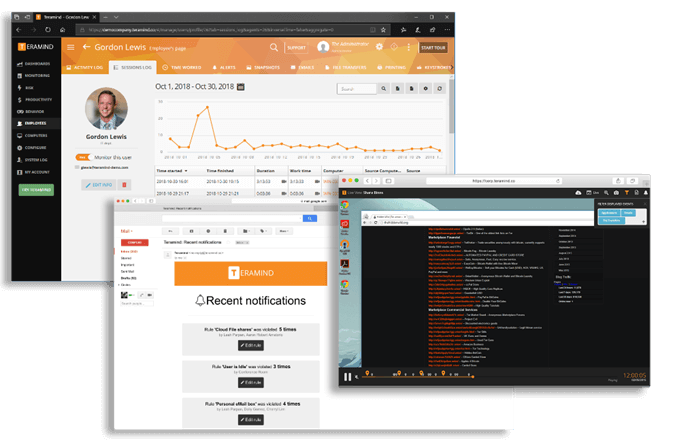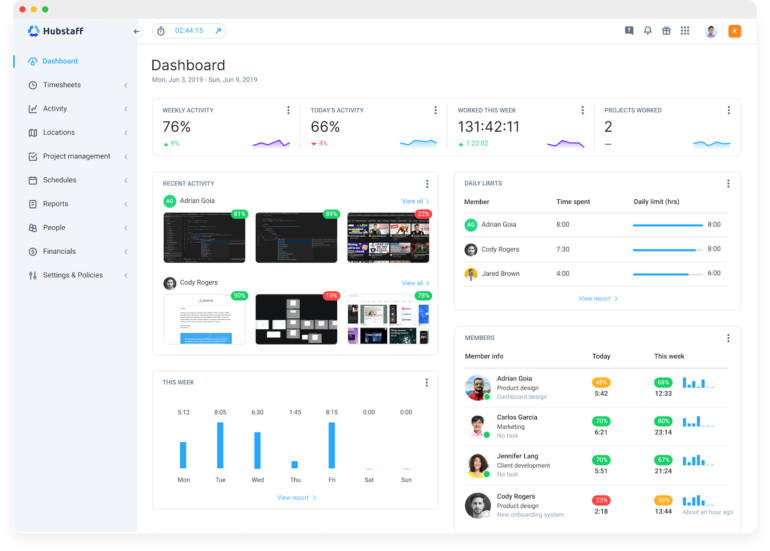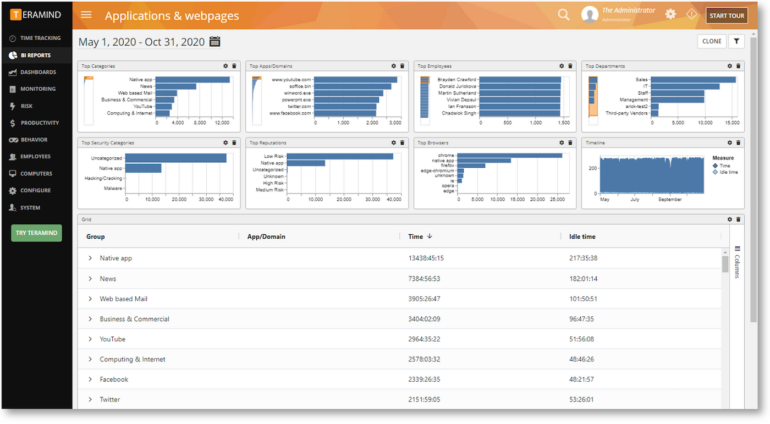Excellent Advice For Choosing Time Tracking Monitoring Service Company
What Exactly Is Employee Monitoring Software And What Do I Have To Know Before I Choose?It's a kind of software that enables organizations to track, monitor and track the activities of their employees. Employers can collect information on employee activities like Internet use, application usages, keystrokes or even screenshots. Employee monitoring software has a primary purpose to increase employee productivity, make sure that policies of the company are adhered to, protect sensitive info, and resolve any security concerns. When choosing an employee tracking software, there are a lot of things to consider. These are the main things to remember features: Decide on the features your organization needs based on its requirements. Common features include blocking of websites keys, keystroke logs, applications use tracking, and monitoring of emails. Choose features that are compatible with your monitoring objectives.
Privacy and Compliance. Check that your software complies with all applicable legal and moral guidelines. Familiarize yourself with applicable laws and regulations in your area, for example data protection and privacy laws. Software that safeguards privacy for employees should have transparent and configurable settings.
User-Friendliness: Think about the software's accessibility and usability. A user interface that is easy to use and a easy installation will help you save time and make it easier to implement. Think about customizing your dashboards and incorporating intuitive reporting features to help you quickly navigate and interpret information.
Integrity and compatibility- Check that the application works with your current IT infrastructure, which includes the operating system and email client, as well as the project management software and collaboration platform. Monitoring that is compatible ensures smooth operation without causing disruptions to day-today operations.
Data Security: Examine the software’s security measures for safeguarding the collected information. Access controls and encryption, secure storage of data, and compliance with industry standard security protocols are essential. Verify the software's security practices.
Scalability: Take into consideration how the software will scale to meet the needs of your growing organization. If you're looking to expand your team or add new locations, you should choose a software that is easily adjusted to meet the needs of your business.
Reporting and Analytical Capabilities- Examine the reporting and analytical capabilities of the program. Features that provide a comprehensive view into employee productivity, time management, and other trends are crucial to consider. Customized analytics and reports can assist you in identifying areas for improvement and make informed choices.
Customer Support- Assess the level of support offered by the software provider. You can determine their speed of response, accessibility as well as the technical support that they provide. A good customer support team will provide prompt assistance to any issue that might arise.
Cost - Be aware of the pricing model that you are using, for example, an annual fee, a subscription, or depending on usage. Be aware of the cost and whether there are any extra costs for support, upgrades, or additional features. Make sure you balance the cost of your product in relation to its value and features.
Transparency and Communication among employees Create an open and transparent dialogue with your staff about the implementation and usage of software for monitoring. Be clear about the goal the scope and the expectations of the monitoring. Discuss any concerns that they might have, as well as assure them of confidentiality of their information.
When you look at these aspects you can make an educated decision that is in line with your company's particular needs and protects employees' privacy while meeting all lawful requirements. Have a look at the top employee monitoring company for blog tips.

What Are The Features Of The Employee Monitoring Software? And How Do They Vary?
Employee monitoring software has many options for analyzing and tracking the activities of employees. Monitoring software for employees can have diverse options. Here are a few typical features. Activity Monitoring - This feature records and tracks all employee actions including sites visited, the programs utilized, files accessed, and the time spent. It gives a complete review of how employees use their time at work.
Keystroke Logging: Keystroke logs track every single keystroke made by employees. It is a way to detect productivity bottlenecks and also identify unauthorized actions and collect evidence to support investigations.
Screenshots and screen recordingsScreenshots, and screen recordings - Certain applications take screenshots of the employee's computer screen at specified intervals. Others record their screen in real-time. This feature may be helpful to monitor productivity levels or troubleshooting.
Internet Usage Tracking: This feature allows employees to monitor their internet activities including the websites they visit, the searches they conduct and downloads. It can help identify excessive non-work related internet browsing, security threats or policy violations.
This feature allows you to keep track of the applications employees use at work. It allows you to see what applications are the most popular, and helps to identify inappropriate or illegal applications.
Email Monitoring lets employers check all emails sent by employees. This includes sent and received emails, attachments to emails and email content. It assists in ensuring the compliance of policies of the company, stop leakage of data and examine any suspicious behavior.
Tracking of files and documents - This feature lets you track file modifications as well as access and transfers. It helps safeguard sensitive data by monitoring document collaboration and ensuring compliance with data security policies.
Remote Monitoring permits employers to monitor employees that work remotely or in different locations. Employers can track their activities and ensure productivity regardless of their physical location.
Productivity AnalysisMonitoring software for employees often includes productivity analysis features that offer insight into work patterns of employees as well as time allocation and overall levels of productivity. These analyses can be used to improve workflow and pinpoint areas to improve.
Reporting and Analytics - The robust features for reporting and analytics create detailed reports using the information that has been collected. These reports provide valuable insight into the performance of employees in resource allocation, as well as time management.
Compliance and Policy Management- Some software solutions provide features that ensure compliance with industry regulations and company policies. They allow employers to define and enforce policies related to acceptable computer usage, internet access, and security of data.
Alerts and notifications - Alerts or notifications notify managers or employers about specific activities or events. They could alert them to excessive internet use or attempts to gain access to restricted websites or unusual behavior.
The features and capabilities of the features can vary between various products for employee surveillance. When selecting a software, take into consideration the features that match your monitoring goals and comply with ethical and legal guidelines within your area of operation. Have a look at the recommended employee monitoring services for website recommendations.

What Is The Compliance And Privacy Law Regarding Employee Monitoring Software?
It is crucial that the software used for monitoring employees is compliant and adheres to data privacy laws. The specific legal requirements will differ from one jurisdiction to the next, however here are some common ways the software used by employees adheres to the laws on privacy and compliance: Consent and Notice - A majority of jurisdictions require informed consent for employees and prior notification of any monitoring activities. Monitoring programs for employees typically include features that enable employers to clearly communicate monitoring policies with employees. This could include providing written notifications, obtaining consent by using consent forms, or establishing an employee guide that outlines the guidelines for monitoring.
Transparent Monitoring Polices - Employee monitoring tools encourage transparency. They make sure that employees are aware of what kinds of information are being collected and why, as well in the scope of monitoring. An explicit and thorough policy can help employees to understand the boundaries of monitoring and their privacy rights.
Data minimization - In order to ensure compliance with privacy laws and employ monitoring software, data minimization is often utilized. It means only necessary data is collected and retained, and irrelevant or excessive information is kept out of the system. By restricting data collection to the essentials to be monitored This software minimizes the risk of privacy and encourages compliance.
Anonymization and Aggregation- Some employee monitoring software can anonymize or aggregate data to protect employee privacy further. Anonymization eliminates personally identifiable data (PII) from data which makes it impossible to connect information with specific individuals. Aggregation is the process of combining data from many employees to provide insights at an aggregate level, without single out individuals.
Secure Data Store and Encryption: Employee monitoring software places the security of the data it collects first. Data is protected with secure practices for data storage and encryption methods. It is essential to protect the data during transport as well as in storage.
Access Controls, Restricted Permissions – To ensure compliance with regulations, monitoring software for employees provides the ability to grant access and permissions in a granular manner. Employers can limit access to monitoring data for authorized users who need the data for legitimate purposes, such as HR personnel or administrators designated by the company.
Rights of the Employee RightsRespecting the rights of employees means ensuring compliance with privacy legislation. Many employee monitoring programs include options that let employees access their own personal information as well as make corrections and make complaints. It allows employees the right to seek recourse in case of a privacy violation, and also exercise their rights.
Compliance with Data Protection Regulations – Employee monitoring software is designed in conformity with the applicable regulations on data privacy, such as the General Data Protection Regulations (GDPR), in the European Union, or the California Consumer Privacy Acts (CCPA) in the United States. Compliance means implementing data protection measures and respecting the rights of data subjects and ensuring legal processing.
Alongside using employee monitoring tools businesses should also seek out legal experts and keep up-to-date on laws and rules in their area of responsibility. A thorough approach to ensuring compliance with privacy and compliance laws is essential, and extends beyond the software. It involves clearly defined policies, along with training employees and continuous monitoring. View the top rated employee monitoring services for website examples.
